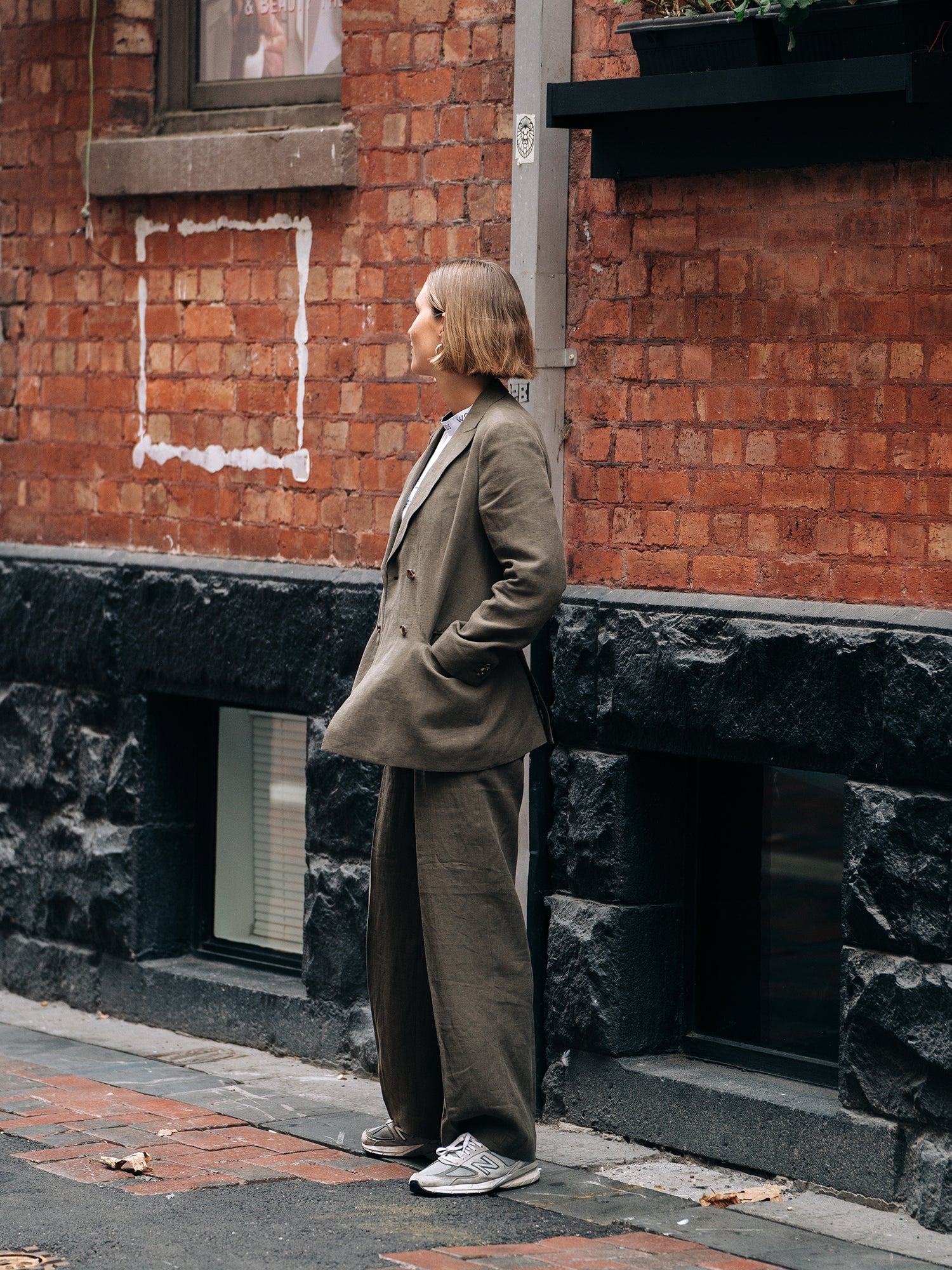Amity Guild x Oscar Hunt
If there’s one thing we appreciate at Oscar Hunt it’s perseverance - the pursuit of that perfect cut, the best cloth or providing the most enjoyable tailoring experience. And it’s this commitment to excellence (and, to be frank, sheer determination) that makes our newest partnership such a perfect fit.
Enter Amity Guild.

Amity Guild x Oscar Hunt
A social enterprise that collaborates with Indigenous artists to create quality garments and, in doing so, puts First Nations culture in the spotlight.
Our collaboration sees the work of these artists printed onto exclusive jacket linen which then features in our suits. The proceeds from the sale are then divided between the artist and impact initiatives, which enriches our connection with First Nations culture and community.
Beyond the garments themselves though, the partnership represents a commitment to building upon the stories shared by First Nations ancestors whilst also providing a platform to spark conversations and empower people to bring a small piece of this 60,000 year old culture into their homes and workplaces.
To launch this collaboration with the panache it deserves, we sat down this week with Amity Guild ambassador Rona Glynn-McDonald.
Rona is a proud Kaytetye woman and founder and CEO of Common Ground - a First Nations led not-for-profit working with Amity Guild to amplify cultural storytelling projects.
Also a 2020 finalist for the Victorian Young Achiever Awards, winner of the Westpac Social Change Fellowship, Diana Award recipient and named ‘Woman of the Future’ by Women’s Weekly, she’s something of a force to be reckoned with and the perfect person to expand on the significance of this partnership.

What impact are you working towards, and what does success look like?
Since 1788, Australia has been largely shaped and governed by colonial narratives and systems of power. These narratives and systems do not consider First Nations voices, knowledge and solutions.
Growing up in Mparntwe (Alice Springs), I saw the way our voices were rarely centered in many of the systems that impact our lives - whether that was in health, education or our economic systems.
There were so many moments in my life where I saw how community-driven storytelling can shape better outcomes, but there were very few opportunities for that to occur.
That’s how and why Common Ground was born. To create safe spaces where First Nations people can share their stories and perspectives, shifting away from colonial narratives to shape new systems that centre First Nations people, and our ways of being and knowing.
For me success looks like shifting this continent toward centering First Nations people, knowledge, aspirations and solutions.
Who or what inspires you? Why?
I am inspired everyday by my Elders. These are strong people that ground me, and push me to push for change across this continent. To exist with joy and strength as a form of resistance.
My Grandmother Freda Glynn, was a media pioneer, launching the first Aboriginal media association in the world. This space she fought for, allowed CAAMA to become an incubator for Australian talent - a radio station, a video production company, a recording label for First Nations musicians then, through Imparja, a satellite television service that reached hundreds of communities.
CAAMA kept our languages alive, and allowed our people to record and celebrate our culture, even if only in our own communities. My grandmother is a Matriarch, and there are many more matriarchs from across our first cultures.
‘Getting on with it’ is a phrase that my nana Freda Glynn uses over and over in everyday conversation, whether she was telling off her kids, her grandkids, or batting away interviewers, or remembering her life as a single mother of five children during the 1970s. Apparently you just got on with it, whether that meant going to University in Adelaide at a time when few Indigenous people did, or being a senior bureaucrat lobbying Canberra for resources.
Role models like my nana Freda Glynn, make it possible to reach for success today.
They have broken down the walls and barriers that the world has placed before First Nations women. Their work enables us to see that we can “just get on with it” and resist the current colonial world we live in to shape a better world for our future ancestors.
What does a reconciled nation look like/feel like?
For me, we need more than reconciliation. We need reparations, regeneration and reciprocity. These futures will heal beyond current injustice and shape spaces that centre the aspirations and voices of First Nations people.
What is your vision for Australia?
My vision for our future is one that centres First Nations people, knowledge, aspirations and solutions. Where our young people and old people’s voices aren’t just heard but centered in every system across this continent.
Why do you think it is important to have culture more visible in all areas of society?
When we celebrate and centre culture, we centre storylines and knowledges that been held by First Nations communities since time immemorial. By shaping spaces for our cultures to be centered, we are building futures built on knowledges, learnings and solutions as old as time.
What is the key piece of advice you offer other Aboriginal and/or Torres Strait Islander young people?
Focus on being strong in yourself, strong in your relationship with Country, your Ancestors, your Elders and communities. When we are strong in those ways we can step out and truly shift the world we live in.
Eager to learn more about the featured lining?
The work is Sacred Rocks by Stan Yarramunua. It is reflective of the sacred rocks and other landforms used by First Nations people to mark ancient paths. These storylines and songlines connect Australia’s many nations and peoples.
A persona is reflected within this work; The Artist. This speaks to those who are creative and curious with an eye for innovation and disruption.
A perfect way to describe our illustrious ambassador - Rona.










